


 |
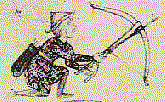 The Art and Science of Hurling
The Art and Science of Hurling
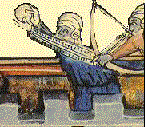 The bow is probably the first mechanical device invented to achieve projectile speeds faster than those attainable by throwing. Energy supplied by the human arm is stored in the bow limbs while the bow is drawn. The stored energy is then released as the kinetic energy of the arrow. This is a very efficient process since a large fraction of the stored energy gets converted into the motion of the arrow. Compare shooting an arrow this way and throwing it by hand. In both cases its is the arm muscles that provide the energy. When you simply throw the arrow you also "throw" the arm. Since the arm is much more massive than the arrow it gets the lion share of the energy
The bow is probably the first mechanical device invented to achieve projectile speeds faster than those attainable by throwing. Energy supplied by the human arm is stored in the bow limbs while the bow is drawn. The stored energy is then released as the kinetic energy of the arrow. This is a very efficient process since a large fraction of the stored energy gets converted into the motion of the arrow. Compare shooting an arrow this way and throwing it by hand. In both cases its is the arm muscles that provide the energy. When you simply throw the arrow you also "throw" the arm. Since the arm is much more massive than the arrow it gets the lion share of the energy
There is evidence to suggest that the bow developed as a hunting tool in many locations simultaneously as long as 40,000 years ago. Bows are still widely used today for sport and occasionally for warfare. The early bows (self bows), were made of a single material, probably wood. Ultimately several different materials were glued together to make the composite bow.
Historically these materials included wood and animal products such as horn and sinew and glue. Today composite bows are made of synthetic materials.
During the middle ages the short self bow gave way to the superior longbow. The longbow of the English archers, made from the English yew tree, is the legendary bow of the famous historical battles. The wooden longbow was the mainstay of Western archery until the middle of this century when it was replaced by the laminated composite longbow, made of laminated wood, plastic and fiberglass. The modern composite bow is less affected by variations in temperature and humidity than its wooden cousin. Similarly the wooden arrows of the past have been replaced by aluminum or fiberglass tubes. In place of the traditional feather fletch modern arrows sport plastic fins.
The longbow had a range of over 200 yards and was a formidable weapon. An experienced archer could discharge 8 arrows in 30 seconds. During the
heyday of longbow archery in the 12th century England every man had to practice archery on Sundays and holidays. The king's archers practiced 7 days a week, 6 -8 hours a day.
During the 12th century the crossbow, developed in Europe and introduced to England by the Normans, started to compete with the longbow. The crossbow was a superior weapon for siege warfare as was the trebuchet, developed in the same time period. These engines of war eventually passed into history as the gunpowder weapons replaced them in the 16th century.
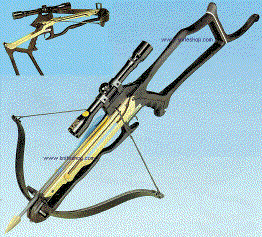 The crossbow, which eventually served the model for the modern rifle, consisted of a stock and a short bow mounted on it. It was fired from the shoulder. It was quite a bit more powerful than the long bow but it took longer to load. The simplest way to load a crossbow was to span it by hand. The bowman would place his foot into a stirrup in the middle of the bow and pull back the bowstring. Eventually mechanical devices such as cord and pulley, bending lever and windlass were added to help the hand. In some countries fairly large crossbows were built. The archer would lie on his back and operate the bow with his feet. In the later centuries sights were added to the crossbow for more accurate aiming. Lead, clay and steel balls were added to the arsenal and some bows were equipped with barrels. When gun powder was introduced the rifle inherited many characteristics of the crossbow.
Modern crossbows are made of composite materials and are quite elaborate.
Crossbows, such as the one in the picture, can be obtained from
The Knife Shop. The body of this bow is made of Dural, black anodice compound, the bow is made of fiberglass.
The crossbow, which eventually served the model for the modern rifle, consisted of a stock and a short bow mounted on it. It was fired from the shoulder. It was quite a bit more powerful than the long bow but it took longer to load. The simplest way to load a crossbow was to span it by hand. The bowman would place his foot into a stirrup in the middle of the bow and pull back the bowstring. Eventually mechanical devices such as cord and pulley, bending lever and windlass were added to help the hand. In some countries fairly large crossbows were built. The archer would lie on his back and operate the bow with his feet. In the later centuries sights were added to the crossbow for more accurate aiming. Lead, clay and steel balls were added to the arsenal and some bows were equipped with barrels. When gun powder was introduced the rifle inherited many characteristics of the crossbow.
Modern crossbows are made of composite materials and are quite elaborate.
Crossbows, such as the one in the picture, can be obtained from
The Knife Shop. The body of this bow is made of Dural, black anodice compound, the bow is made of fiberglass.
A medieval crossbow could fire a heavy metal tipped arrow with an initial velocity of 150 ft/s. Such an arrow could pierce the thickest armor.
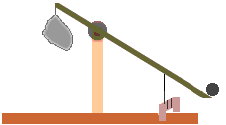 The Trebuchet is the ultimate hurling machine. The medieval designers cleverly used the force of gravity and their understanding of the lever to produce a device that can throw a 1400 lb car 87 yards.
The Trebuchet is the ultimate hurling machine. The medieval designers cleverly used the force of gravity and their understanding of the lever to produce a device that can throw a 1400 lb car 87 yards.
The
simple trebuchet is a large lever with a heavy weight at its short end and a projectile basket at the long end. The long end is pulled back with winch-drawn ropes. When the lever is released even a heavy missile at the other end of the lever can attain very high velocity. 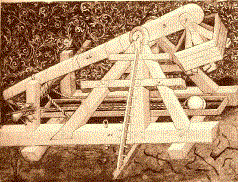 An interesting improvement on the simple design was to attach a rope to the long end of the lever. The rope would than swing up as the lever was released and bring with it the projectile. At the appropriate point on the swing trajectory the rope would be cut to release the missile.
Physicists of the present day are trying to find out how much physics, as opposed to trial and error, was involved in the design and use of these weapons.
An interesting improvement on the simple design was to attach a rope to the long end of the lever. The rope would than swing up as the lever was released and bring with it the projectile. At the appropriate point on the swing trajectory the rope would be cut to release the missile.
Physicists of the present day are trying to find out how much physics, as opposed to trial and error, was involved in the design and use of these weapons.
Eventually the weights powering these devices, as well as the projectiles, got quite heavy. The trebuchet was a formidable
siege weapon. It could heave large objects into and over the walls of medieval fortresses. All it lacked was accuracy. There was no way to aim the thing. Friendly trebuchet fire must have been a frequent hazard on the medieval battlefield.
 What is the initial velocity of an arrow shot from a modern hunting bow?
What is the initial velocity of an arrow shot from a modern hunting bow?
 Does anyone still make Trebuchets today?
Does anyone still make Trebuchets today?
 How accurate are modern sports bows?
How accurate are modern sports bows?
 Is there such a thing as a modern sling shot?
Is there such a thing as a modern sling shot?